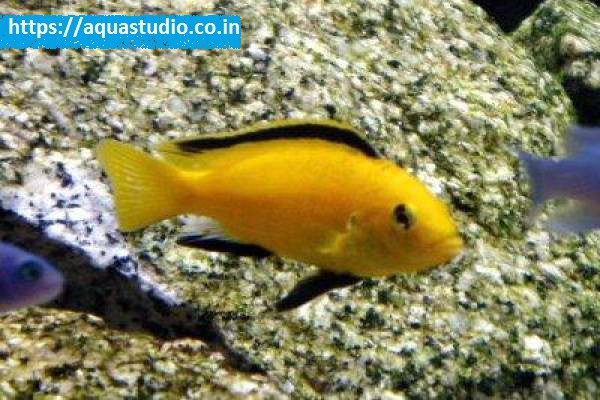Scientific name: Labidochromis caeruleus Common name: Electric yellow cichlid Family: Cichlidae Usual size in fish tanks: 8 - 10 cm (3.15 - 3.94 inch) 0 14 Recommended pH range for the species: 7 - 8.5 Recommended water hardness (dGH): 10 - 30°N (178.57 - 535.71ppm) 0°C 32°F 30°C 86°F Recommended temperature: 22 - 28 °C (71.6 - 82.4°F) The way how these fish reproduce: Spawning Where the species comes from: Africa Temperament to its own species: peaceful Temperament toward other fish species: peaceful Usual place in the tank: Bottom levels Feeding For a healthy diet, Electric yellow cichlid will need both meaty food and greens. For greens, give them algae and vegetable flakes and pellets (those containing spirulina are great), from time to time spinach, lettuce, peas, and for meat use life or frozen bloodworms, brine shrimps and some larvae. Don’t overfeed, otherwise they’ll get overweight and the water quality will drop too. Enough food should be the amount they eat within 5 minutes if you feed them once a day or 3 minutes if you feed them twice a day. Origin In nature, they can be found in the Lake Malawi between the islands of Charo and Mbowe where they live either in deeper rocky waters, or in shallow waters among high water plants like the Vallisneria's. Sexing The male and the female are very similar and the submissive males are even more so. The easiest is to identify a dominant male. He’ll have much brighter yellow colouration, the anal and pelvic fins will be jet-black and longer than females’. The male’s dorsal fin is black too, but with a yellow edge. Older males can develop some dirty-looking colouration on their faces. Females on the other hand should have yellow dorsal (sometimes it is only lighter black), anal and pelvic fins, and they are smaller. The subdominant males are more tricky. Their anal and pelvic fins can vary from light black to yellow, so sometimes it is very hard to tell them apart from females, but they still should be bigger than females. Breeding Electric yellow cichlid is a mouthbrooder and it is quite normal for them to breed in home aquariums. They start breeding when they are about 5 or 6 cm (1.97 - 2.36 inch) long. At this size they should be about 6 months old, which is the age when they are sexually mature. Spawning occurred mostly after the hobbyist lowered the water level for a day and then added clean water. Firstly a male will choose a spot, mostly some nice flat stone, then the female lays her eggs there, the male will fertilize them and after that the female will collect them into her mouth. They repeat this process few times and then the female will hide for about 3 weeks. Young inexperienced females have about 10 fry, older ones can have 30. If the female has a good hiding place, she can be kept in the main tank during the incubation and the fry should be safe with their parents even after they are released. In fact if you try to remove the female after she releases her young, she may become so stressed, she eats her babies. The fry can be fed with brine shrimps or crushed flakes after their yolk is absorbed. Lifespan Under right conditions they can live up to 10 years. Tank requirements This cichlid needs at least 70 gallon or 250 litre per one male and few females. The water should be hard, slightly alkaline and always clean to ensure the proper health of fish. The decoration should simulate their natural habitat, so divide your tank into two parts. One should be overgrown with plants, Vallisneria is perfect and it is quite common in aquarium trade too, just secure the roots. Leave the second part open for free swimming space with rocks and caves at the bottom. The best substrate for an Electric yellow cichlid is sand or fine gravel, since they like to dig in it. Tank mates This is one of the more peaceful cichlids, but it is still semi-aggressive and territorial, especially toward similar coloured and shaped fish, as well as toward males from the same specie. It is because they are seen as competition for food and females. But even if they fight, serious injuries are only rare, especially if they have enough room. In small or overcrowded tanks the fights can get more dangerous. Females on the other hand will be safe and can be safely kept in one tank with a male. In fact the best is to keep 3 or more females per one male, because males will spend most of their time chasing them. Best tank mates are larger fish which will not be seen as competition, nor as food. Short description In the wild this “yellow” cichlid is normally light blue with a little bit of white. This strain of the Labidochromis caeruleus was the “rare” colour variation when it was first discovered. Due to their ease of breeding in the aquarium industry, the Electric Yellow Cichlid is one that is readily available to aquarists everywhere while the light blue-white variety has been forgotten. This fish has another common names: Blue streak hap, Labidochromis white, Labidochromis yellow, Yellow prince. Please, check the Randy’s comment below for the temperament/compatibility experience. Pictures Pictures were provided by Alberto Villarroya. Thanks! Questions/Answers On March 23th 2012 the below-shown questions and answers were added here due to merging aqua-fish.net/answers with related pages. Which fish are compatible with the electric yellow cichlids? Answer: The electric yellow cichlids is an African cichlid, it should be kept in a Malawi set up with other Malawi cichlids. How can I tell if my electric yellows are breeding? Answer: The male yellow will show a more aggressive nature often chasing the female. These fish are mouth brooders so you will often miss out on the actual laying of the eggs.
